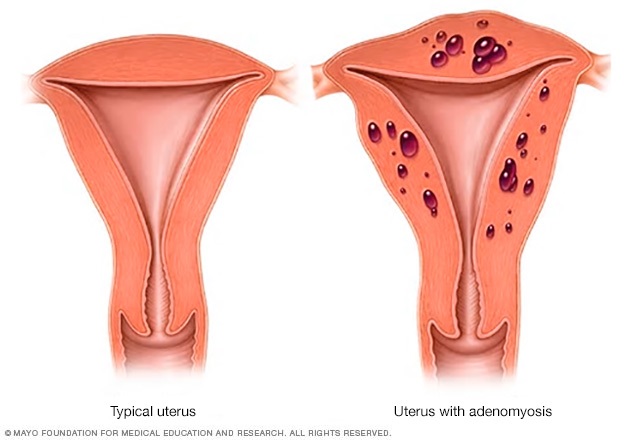Overview
Adenomyosis

Adenomyosis
With adenomyosis, the same type of tissue that lines the uterus is present within the muscles that make up the walls of the uterus. It also can grow from the surface of the uterus into the walls of the uterus. This tissue also is known as endometrial tissue.
Adenomyosis (ad-uh-no-my-O-sis) occurs when the tissue that normally lines the uterus (endometrial tissue) grows into the muscular wall of the uterus. The displaced tissue continues to act normally — thickening, breaking down and bleeding — during each menstrual cycle. An enlarged uterus and painful, heavy periods can result.
Doctors aren't sure what causes adenomyosis, but the disease usually resolves after menopause. For women who have severe discomfort from adenomyosis, hormonal treatments can help. Removal of the uterus (hysterectomy) cures adenomyosis
Products & Services
Symptoms
Sometimes, adenomyosis causes no signs or symptoms or only mild discomfort. However, adenomyosis can cause:
- Heavy or prolonged menstrual bleeding
- Severe cramping or sharp, knifelike pelvic pain during menstruation (dysmenorrhea)
- Chronic pelvic pain
- Painful intercourse (dyspareunia)
Your uterus might get bigger. Although you might not know if your uterus is bigger, you may notice tenderness or pressure in your lower abdomen.
When to see a doctor
If you have prolonged, heavy bleeding or severe cramping during your periods that interferes with your regular activities, make an appointment to see your doctor.
Causes
The cause of adenomyosis isn't known. There have been many theories, including:
- Invasive tissue growth. Some experts believe that endometrial cells from the lining of the uterus invade the muscle that forms the uterine walls. Uterine incisions made during an operation such as a cesarean section (C-section) might promote the direct invasion of the endometrial cells into the wall of the uterus.
- Developmental origins. Other experts suspect that endometrial tissue is deposited in the uterine muscle when the uterus is first formed in the fetus.
- Uterine inflammation related to childbirth. Another theory suggests a link between adenomyosis and childbirth. Inflammation of the uterine lining during the postpartum period might cause a break in the normal boundary of cells that line the uterus.
- Stem cell origins. A recent theory proposes that bone marrow stem cells might invade the uterine muscle, causing adenomyosis.
Regardless of how adenomyosis develops, its growth depends on the body's circulating estrogen.
Risk factors
Risk factors for adenomyosis include:
- Prior uterine surgery, such as C-section, fibroid removal, or dilatation and curettage (D&C)
- Childbirth
- Middle age
Most cases of adenomyosis — which depends on estrogen — are found in women in their 40s and 50s. Adenomyosis in these women could relate to longer exposure to estrogen compared with that of younger women. However, current research suggests that the condition might also be common in younger women.
Complications
If you often have prolonged, heavy bleeding during your periods, you can develop chronic anemia, which causes fatigue and other health problems.
Although not harmful, the pain and excessive bleeding associated with adenomyosis can disrupt your lifestyle. You might avoid activities you've enjoyed in the past because you're in pain or you worry that you might start bleeding.